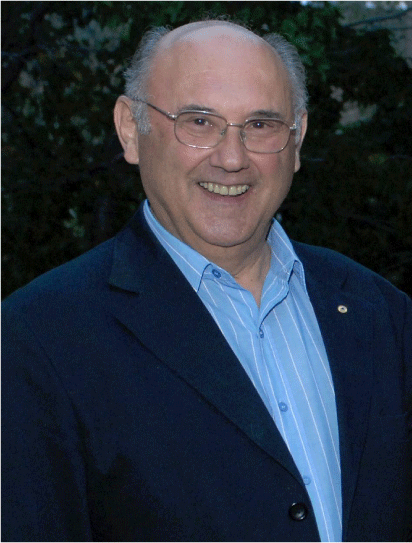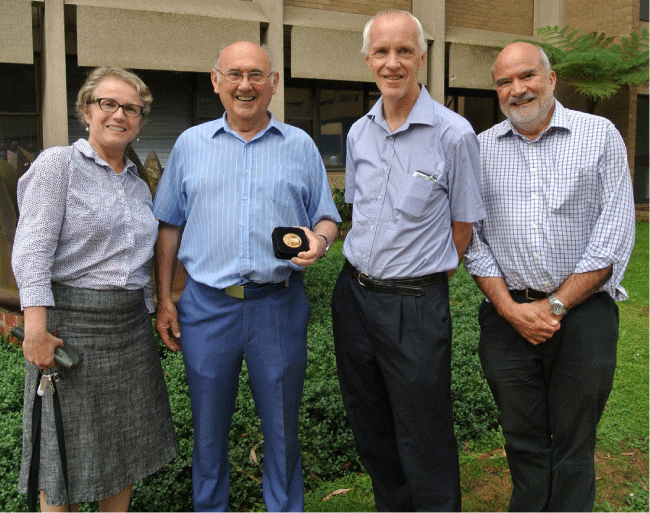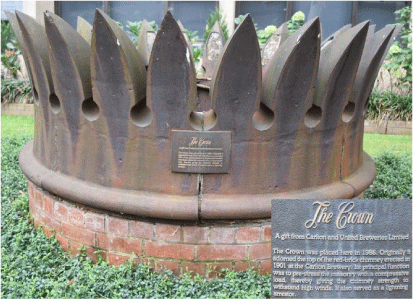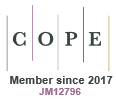Anthony George Klein 1935–2021
Trevor R. Finlayson A , Leon Mann B * , Bruce H. J. McKellar C and David G. Satchell DA
B
C
D
Abstract
Professor Anthony (Tony) George Klein AM, FAA (1935–2021) was an outstanding physicist, university teacher, leader, mentor and science communicator. We recount Tony’s life from his childhood in wartime Romania, his early interest in mathematics, the family’s migration to Australia via Israel in 1953, high school and university education in Melbourne, appointment as a research scientist at the AAEC in Sydney, followed by a distinguished career as an academic, researcher and leader in the School of Physics at the University of Melbourne where he retired as Emeritus Professor. The memoir describes Tony Klein’s personal qualities, the influences and experiences shaping his career, his major research contributions and collaborations in the field of neutron optics and neutron interferometry, his service to scientific and medical organisations and recognition by the university, the Australian Academy of Science and the nation. We evaluate Tony Klein’s contribution to science, knowledge and higher education.
Keywords: Australian Academy of Science, Australian Institute of Physics, Australian Optical Society, Melbourne physics, neutron physics, neutron optics.
Introduction
Anthony George Klein, (Fig. 1) better known as Tony, passed away on 18 November, 2021, following a long and significant career as a professor of physics at the University of Melbourne.
Tony was born in Timisoara, Romania, on 14 December 1935, the only child of Jewish parents, Emeric and Rose Klein. The family survived the Holocaust. Tony’s family migrated to Australia in January 1953 and joined extended family in Melbourne. Tony attended University High School (UHS) in his matriculation year. He studied electrical engineering at the University of Melbourne 1954–7. He was employed as a research scientist at the Australian Atomic Energy Commission (AAEC) in Sydney 1958–64, where he began his life-long interest in neutron physics. He joined the Department of Physics at the University of Melbourne in 1965 where he remained until his death in 2021.
In this memoir we describe Tony’s significant contributions in experimental physics and his service as a Fellow of the Australian Academy of Science, President of the Australian Institute of Physics, President of the Australian Optical Society, and to the university and wider general community. We draw from Tony’s highly informative, remarkably candid and fascinating unpublished memoirs1 covering the early to middle years of his life, his Curriculum Vitae, his entries in Who’s Who Australia 2002, 2008 and 2015 and the various items listed in the section End of life tributes.
Family and childhood
In his memoirs, Tony wrote about his childhood in Romania. When World War 2 broke out in 1939, European Jewry faced the threat of annihilation. Romania was allied with the West at the beginning of the war, but when a fascist military government under the dictatorship of Ion Antonescu seized power in 1940, Romania joined the Nazi alliance. Romanian Jews were then subject to arbitrary confiscation of property, conscription into labour camps, expulsion from their homes, massacres and deportation to the death camps in Poland. Before World War 2, Romania had a Jewish population of 757,000. From 1940 to 1944 around 380,000–400,000 Romanian Jews were murdered, including members of Tony’s family.
Tony describes the parlous situation of Jews in Timisoara, an industrial city of 100,000 people, during the Holocaust. Tony’s father, a factory owner, was conscripted into a forced-labour brigade and threatened with deportation to the death camps. Emeric might have avoided deportation because his textile and leather factory made products essential to the Nazi war effort. It was rumoured that some sympathetic government officials resisted deporting Jews to the death camps because they were ‘unable’ to find the railway trucks for deportation or were taking bribes. Toward the end of the war, Romania changed sides and joined the Allies in 1944. Tony wrote in his memoirs: ‘By some miracle we survived. But I am convinced it was only a matter of time’.2
At war’s end in 1945, Tony, then ten years old, attended the Jewish high school for two years where he studied Romanian, French, English, geography, history, music, mathematics, science, religious studies, athletics and gymnastics. He wrote that he was frequently bored and got into mischief. Tony transferred to an elite high school where he enjoyed algebra and geometry but disliked the mandatory Marxist-Leninist ideological dogma. But, as he reported many years later,3 it was a science teacher, Mr Herscovich, who inspired him, using a simple demonstration of electromagnetism.
In 1952, the Klein family, suffocating from Romania’s post-war authoritarian Communist regime, migrated to Israel, staying there for a year and then moving on to Australia in 1953. Tony spoke often of his deep gratitude for the freedom, tolerance, and opportunity Australia offered. But it also was fitting that he visited Romania in 2005,4 with his grandchildren, to show them the country of his birth.
Arrival and education in Australia
Tony and his parents arrived in Australia in January 1953 on the P&O liner Strathnaver. They were greeted at Station Pier, Port Melbourne, by Vic Spitzer, a cousin Tony had not seen since 1939, and whom he regarded as ‘big brother’. Tony was also reunited with his maternal grandparents who had survived the Holocaust and migrated to Australia in 1948. Tony enrolled in Year 12 at University High School (UHS). A second cousin, Geulah Loven, a teacher, advised him to study pure maths, applied maths, physics, chemistry, and English expression for matriculation, to prepare for a science or engineering degree at university.
There was a large influx of post-war European migrants in the suburbs of Parkville, Carlton, and Brunswick adjoining UHS. Tony found this school, with its high standards, excellent teachers and many students born overseas, a welcoming place. He adapted quickly and was well accepted. Mathematics and science subjects were not a problem for Tony, but English expression may have been a challenge. Tony was encouraged by Mr Russell, his English Expression teacher, to participate in the school debating team and was asked to captain the team in a debate ‘That television should NOT be introduced into Australia.’5 His team won.
Tony achieved honours in pure mathematics, applied mathematics, and chemistry and he passed physics and English Expression (a pass-only subject) in the 1953 matriculation examinations. His excellent results won him a Commonwealth Scholarship to study at university. Tony had adapted successfully to Australia. In his memoir, Tony wrote: ‘I liked the place and felt a deep sense of gratitude to all the people … the teachers and the headmaster, my parents who brought me here, my cousins who gave me advice and encouragement’.6
Tony enrolled in the Bachelor of Engineering degree at the University of Melbourne. In mid-February 1954, and as a ‘fresher’, he began his studies in a two-week engineering drawing course taught by Dr Peter Whitton, later head of mechanical engineering. Tony met his fellow first-year students (all of them male) in the engineering drawing class. Another member of the class was Geoffrey Opat who would become Tony’s lifetime friend.7 Geoff messed up his engineering drawing assignments and decided to change his enrolment from engineering to science and become a physicist. Tony’s friendship with Geoff Opat developed during their undergraduate years, continued in national service with the Melbourne University Regiment, and blossomed throughout their many years as faculty members in the University of Melbourne physics department.
Tony studied physics, mathematics, chemistry, and introduction to engineering in his first year. Dr David Caro, a young senior lecturer, gave the lectures in physics for engineers. Caro lectured at high speed but with brilliant clarity. It was said that ‘taking lectures from this man was like trying to take a sip from a firehose’.8 Tony found Caro’s lectures very stimulating.
Tony achieved excellent results in first-year engineering. He was placed first in engineering mathematics I and equal first in physics, sharing the Dwight Prize.9 Over the summer vacation 1954/5 he found a job in a service station in East Kew, pumping petrol, fixing tyre punctures, cleaning windscreens and sparkplugs, changing engine grease and oil. Tony discovered the value of knowing the cricket score over the summer Ashes series in which England defeated Australia 3-1, because it helped him earn tips. Tony’s wages supplemented the Klein family income and helped pay for the family’s Ford Prefect panel-van that was used for delivering continental delicatessen goods.
In his second-year, 1955, Tony concentrated on electrical engineering. He came first in engineering mathematics II and equal first in properties of engineering materials. He also studied physics II, a science subject.10
In 1955, Tony qualified to become an Australian citizen and was naturalised at a ceremony in the Kew Town Hall. As an Australian citizen, he was then eligible for national service, and he commenced military training with the Melbourne University Regiment in one-month university vacation camps at Puckapunyal.
In third-year engineering, 1956, Tony studied engineering mathematics III and electronics taught by David Caro. He won the exhibition in electronics, first place in engineering mathematics, and the C. G. H. McDonald Prize in electrical engineering,11 which paid for his fourth-year books. Work experience was an engineering degree course requirement. Tony undertook six weeks of work experience in Phillips Industries in Adelaide and in the Commonwealth Scientific and Industrial Research Organisation (CSIRO) engineering division in Melbourne where he calculated the performance of a grid of pipes buried in the ground, to be used in solar energy collection.
Tony’s subjects in fourth-year engineering, 1957, included power engineering and electronics and engineering mathematics IV. He graduated in 1958 with a Bachelor of Engineering degree (in electrical engineering) (BEE) with first-class honours,12 the top student, and winner of the Dixson Scholarship in electrical engineering.
Student life at the University of Melbourne in the 1950s consisted of much more than lectures, tutorials, ‘pracs’ and exams. In his memoirs we learn about the girls Tony fancied and those who fancied him, including Mavis Cohen an ex-UHS student to whom he became engaged in 1957 and married in 1958. Tony captained the engineering team in the annual engineering—law students' marbles match.13 The engineering students played with large steel ball bearings. The law students threw flour-bombs from the roof of the Student Union Building. The engineering students trained an emergency fire hose on the crowd. Vice-Chancellor, Professor George Paton, unimpressed, ‘carpeted’ the two team captains and imposed a fine of ten guineas to pay for drying the hose. Tony, in his memoir, wrote that years later he met the captain of the law students’ marbles team who had become a Justice of the Federal Court of Australia.
Marriage and employment as an electrical engineer
On completing the Bachelor of Electrical Engineering in December 1957, Tony received job offers from the Defence Research Laboratories in Salisbury, South Australia, the Research School of Physical Sciences at the Australian National University, and the Australian Atomic Energy Commission (AAEC) at Lucas Heights, Sydney (now called Australian Nuclear Science and Technology Organisation, ANSTO). He accepted a research scientist position at Lucas Heights to work on instrumentation for the recently built High Flux Australian Reactor (HIFAR). But before moving to Sydney, Tony had to complete one-month of national service over the summer.
In March 1958, Tony and Mavis Cohen were married. They drove to Sydney in April 1958 and rented an apartment in Cronulla close to Lucas Heights, and Tony commenced as a research scientist at the AAEC where Australia’s new reactor had recently gone ‘critical’. He met Dr John Parry, his supervisor, and Dr Arthur Pryor, and in collaboration with Pryor, he was assigned to design a transistorised rate meter for the detection and measurement of neutrons14 for the newly constructed HIFAR. He worked on the design of a logarithmic rate meter for the efficient control of a nuclear reactor during start-up. Publication of this work appeared in 1961.15 He was made secretary of the Reactor Safety Committee.
Secondment in the United States: learning the ropes
Following a visit to the United States of America (USA), Dr Cliff Dalton, AAEC’s chief engineer arranged a secondment for Tony at the Argonne National Laboratory in Chicago, Illinois for 1960–1, in the Reactor Instrumentation and Safety Division. In May 1960, the Klein family, following the birth of their first child, Anita, in February, moved to the USA for a two-year secondment. Tony found his time at the Argonne National Laboratory greatly disappointing. The two senior scientists with whom he expected to work, had left the division and so a junior scientist was in charge and he was unsure what Tony should do, so Tony enrolled in a course in nuclear power, radiation, reactor physics and neutron diffusion theory in the adjoining International Institute of Nuclear Science and Engineering (IINSE), that he found excellent and worthwhile.
The Klein family made a trip to Canada and Tony spent a day at the Canadian Nuclear Research Centre at Chalk River, Ontario, where he was shown the NRX and NRU reactors which used natural un-enriched uranium with heavy water as moderator and primary coolant.
Back at the Argonne National Laboratory Tony worked on a new Digital Data Acquisition System, an early digital computer, made by the Packard Bell Computer Company. The work was interesting but frustrating because no one at the Argonne laboratory provided instruction. After several months, it was decided Tony would transfer for a year to the Oak Ridge National Laboratory (ORNL) in East Tennessee, which had a well-established Instrumentation and Control Division for their Research Reactor.
The time at Oak Ridge was rewarding. In collaboration with John Anderson, a young American engineer, Tony worked on improving control systems for nuclear reactors using analogue computing technology. At the time, the original Oak Ridge Reactor, the X-10 Graphite Reactor that is now a ‘museum-piece’ in Oak Ridge was being phased out while the High Flux Isotope Reactor (HFIR) was under construction. To this day, HFIR remains a most efficient reactor for isotope production and neutron scattering research.
While in the USA, Tony attended the 1960 annual meeting of the American Physical Society (APS) held in New York City.16 The highlight of the meeting for him was a lecture by John Bardeen who had shared the 1956 Nobel Prize in Physics for the invention of the transistor with William Shockley and Walter Brattain. Bardeen’s lecture at the APS meeting was about the new theory of superconductivity, for which Bardeen shared a second Nobel Prize in 1972 with Leon Cooper and Robert Schrieffer.
Return to Australia
Following his time at ORNL, Tony and his family returned to Australia, after a memorable trip across the United States to San Francisco, where they boarded MV Coolgardie, a cargo boat that had accommodation for a few passengers plus their luggage. He was welcomed back to the AAEC where there had been some staff changes but more importantly, HIFAR was increasingly being used for neutron diffraction. This work was initiated by AAEC scientists such as Terry Sabine and Arthur Prior, and Tony was well qualified to contribute to it. He applied new computing techniques using one of the first mini-computers, a Digital Equipment Corporation PDP 8, to develop the instrumentation required to collect neutron scattering data. The other major project in which he was involved was an investigation into the pebble-bed reactor.
In April 1963, the Klein’s second daughter, Stella, was born. Around this time, Tony, although promoted to senior research scientist at the AAEC, was dissatisfied with his work and considered changing careers to a university teaching and a research position. In 1964, he visited Melbourne to investigate job opportunities at the electrical engineering departments at Monash University and the University of Melbourne and the physics department at Melbourne. Professor David Caro, his former teacher and mentor, now head of the physics department, encouraged Tony to apply for a position.
Transfer to academia—the University of Melbourne Department of Physics
At the end of 1964, Tony applied for a senior lectureship in physics at the University of Melbourne. He received an offer and took up the appointment on 1 January, 1965. Over a period of thirty years, Tony progressed steadily on the career path at Melbourne from senior lecturer 1965–76, to reader 1976–83, to professor with a personal chair 1983–98, to head of the School of Physics 1987–96, and to honorary professorial fellow in 1998 and subsequently emeritus professor.
Much of the research undertaken by Tony Klein qualifies as significant research, a term denoting research undertaken by an individual or a team that can be significant for reasons such as that it can be published in a paper which starts a new field of research, or reports on a new experimental technique that allows a previously proposed experiment to be carried out, or allows an existing theoretical suggestion to be verified experimentally.
Soon after arriving in the department, he went to a talk on the anomalous transmission of X-rays (and neutrons) in perfect crystals, called the Borrmann effect,17 by Hein Wagenfeld, a member of John Cowley’s diffraction group. Tony hypothesised that the Borrmann effect could be made to come and go by using a piezo-electric quartz crystal as the ‘perfect’ crystal. By inducing a strain wave in it, one would destroy and recreate the ‘perfect’ spacing of the crystal and cause the Borrmann effect to come and go. The apparatus was built in Melbourne and the experiment was done with neutrons at the Lucas Heights reactor with the collaboration of his former colleagues there. Modulation of the effect had been observed qualitatively with X-rays, in the 1930s.18 To everyone’s surprise the anomalous diffraction was enhanced rather than reduced at double the crystal oscillation frequency. Observations published a year earlier found the effect at the crystal oscillation frequency, and it was shown that their apparatus could not adequately determine the modulation frequency.19 Tony was able to provide a semi-quantitative explanation of the enhanced effect, and the paper was eventually published in 1967.20 Tony never followed up this work, but he and his colleagues had observed and explained a new effect that went on to be exploited in various devices used for producing pulses of neutrons. Their work was still inspiring new research into the 2020s.21 It started a new field of research and applications, and was his first significant research work.
After this work, Tony joined a new research group in the School of Physics, working on accelerator particle physics. Physicists at Melbourne, led by Victor Hopper, had been involved in cosmic ray physics by flying photographic emulsions at high altitude under balloons that gave them access to the interactions of high energy particles. By the 1960s this avenue to high energy physics was being replaced by experiments done with high energy accelerators. At the University of Sydney, under Harry Messel and Brian McCusker, their cosmic ray experiments had been upgraded to gathering data electronically.22 They were to reach energies well above those accessible to the accelerators, and to analyse the results using computers. Melbourne physicists wishing to continue to work on cosmic rays, had moved to Sydney or followed Victor Hopper when he became the inaugural Professor of Physics at the RAAF Academy at Point Cook. David Caro established a group working on accelerator particle physics which had access to the bubble chamber at the Brookhaven Super-Proton-Synchrotron. Tony was a member of this group which took stereoscopic photographs of reactions in the bubble chamber, and analysed the photographs in Melbourne. The work is well described in Tony’s biographical memoir of Geoff Opat.23
The experiments began with managing the beam in the Brookhaven bubble chamber to take photographs for analysis. Geoff Opat ran the first experiment, Tony and David Caro the second. David Caro and Tony produced a Brookhaven report on how to operate the system for delivering antiprotons to the bubble chamber. During delays in Brookhaven, Tony travelled to the University of Cambridge to meet with Australian physicist John Rushbrooke24 who introduced him to Otto Frisch25 the co-designer of the first theoretical mechanism for the detonation of an atomic bomb in 1940. Later in his career Frisch designed a device named Sweepnik that used a laser and computer to measure particle tracks in bubble chambers. Impressed by Frisch’s system, Tony decided to build a Melbourne version of the film measuring machine. The project was completed in 1972–3, but Tony discovered the Cambridge and Melbourne Sweepniks were no faster in measuring particle tracks than well trained people. It was a disappointing end to the Melbourne project, but Tony learned much about optical techniques that was useful for later work.
Over the decade 1970–80 the Brookhaven bubble chamber experiments produced a series of papers by Tony and other members of the Melbourne High Energy Physics group.26 The experiments were typical of research in high energy physics at the time, with new results confirmed by later experiments with greater precision and better control of systematic errors.
In the early 1970s, it became clear that high energy physics experiments were moving away from bubble chamber photographs to electronic observations of the bubble chambers and other particle detectors. Stuart Tovey, recruited to the high energy physics group, had connections with the European Organization for Nuclear Research (Conseil Européen pour la Recherche Nucléaire, CERN) in Geneva, and became a key contributor to high energy physics at Melbourne. Tony and Geoff were ready for new research opportunities.
Two major events shaped Tony’s family life and professional career in the early 1970s. While on a shortened study leave at University College, London in 1971, Tony and Mavis decided to divorce, following several years of marital tension.
A second defining event was the visit to Melbourne in 1973 by Yuval Ne’eman, an eminent theoretical physicist at Tel Aviv University, who told Tony Klein and Geoff Opat about the 1967 work of Y. Aharonov and L. Susskind.27 They had pointed out that a basic result in quantum mechanics,28 essential for our understanding of atomic physics, can be observed in neutron interference experiments. This is the change in the sign of the wavefunction of a particle whose intrinsic angular momentum is in the usual quantum mechanical units, upon rotation through 360°, or 2π radians. While it is observable in such experiments, it does not show up in measurements of the position or polarisation of the particle that are determined by the square of the wavefunction. The same suggestion had been independently made at almost the same time by H. J. Bernstein.29 By September 1974, Tony and Geoff had written up their proposal for an experiment, in a paper that very elegantly describes how the direct observation of the change of sign may be made by interference of rotated and unrotated neutrons.30 To do the experiment, a very intense neutron beam was required, and Klein and Opat secured the support and the personal approval of Rudolf Mössbauer, the director of the Institut Laue–Langevin, for the experiment to be done there. However, Rauch and others in Vienna, and Werner and others at the University of Missouri, completed similar but different experiments both of which were published in October 1975.31
Nevertheless, Mössbauer encouraged Klein and Opat to conduct their experiment. The experimental observations were a family effort. Tony’s partner, Suzanne Gurvich, whom he married in 1979, accompanied him to Grenoble, where she visually counted the 100,000 spots on the film to record the results. The experimental results published in mid-1976,32 demonstrated the change of sign associated with 2π rotations by showing results for 9.2 × (2π), 10.2 × (2π) and 11.2 × (2π). The change of sign was clear in the first and third cases and absent in the second. The experiment became well known and cited in textbooks.
The experimental realisation of interference for neutrons was a critically important step in the experimental demonstration of the wave optics of neutrons. The work formed the basis of Tony’s PhD thesis,33 supervised by David Caro, his mentor. In doing the 2π rotation experiment, all three groups relied on interference experiments that exploited the wave nature of the neutron and used the wave optics of light as an analogy. In the next thirty years the teams separately and together made major contributions to the establishment and development of the field of neutron optics.
The 1970s and 1980s were a highly productive period for Tony and his PhD students in Melbourne and their research collaborators in different countries. Together with Al Cimmino,34 and European collaborators, Tony demonstrated that the well-known Fizeau effect for light, whereby light waves experience a change of phase in a moving medium,35 was also true for neutrons.36 Tony and Geoff Opat co-supervised Patrick Kearney’s PhD thesis research on the focussing of neutrons and the production of zone plates to achieve focussing.37 Another PhD student, Will Hamilton, studied three areas of neutron optics: diffraction of cold neutrons by surface acoustic waves; the neutron interferometric analogue of the classic experiment of Fizeau on the propagation of light in flowing water; and a theoretical discussion of the concept of coherence under dispersive propagation. Hamilton’s thesis benefitted from collaboration with Dr Peter Timmins at the Institut Laue–Langevin and Professor Sam Werner in Missouri.38 PhD student Brendan Allman researched aspects of both light and neutron optics,39 the latter in collaboration with Werner’s Missouri group.
His continued success meant Tony was able to prepare and present a thesis in 1986, entitled ‘Contributions to Neutron Optics’ that brought together twenty-two of his publications between 1967 and 1986, and for which he was awarded a DSc.40 Two major contributions for this thesis were reviews of neutron optics: the 79-page review he had written with his colleague Sam Werner and which had been published as a chapter in a volume of Methods in Experimental Physics,41 and an invited review of 77 pages for Reports on Progress in Physics.42 This latter review has been cited 239 times.43
These developments in neutron optics laid the foundations for the crucial experimental determination in 1989 of the Aharonov–Casher (AC) topological phase shift by neutron interferometry.44 The experiment was a collaboration between the Melbourne group and the Werner group in Missouri. The AC effect is the phase generated when a particle with a magnetic moment makes a closed path around an excluded region, which the particle is unable to enter or pass through. It is as if the particle were travelling around a donut but has to stay in the donut and cannot enter the hole, whereas the electric field goes through the hole. It is topological if the angle between the magnetic moment and the path is constant, and the phase depends on the fields in the excluded region. In the experiment of Cimmino and others, the theoretically predicted phase was 1.5 mrad and the observed phase was (2.19 ± 0.52) mrad. In 1995, Sangster and others obtained results which were within 2% of the predicted values.45 However, instead of the path encircling the excluded region and having a magnetic moment always normal to the path, in this experiment the neutrons travelled in two paths which went on the same side of the electric charges and the magnetic moment was in opposite directions on those paths. It is reasonable to argue that this phase is a form of the AC effect, but it is clearly not topological. Tony Klein and his collaborators had the most precise measurement until the Toulouse experiments of 2014 that obtained results within 3% of the calculated values.46 The Cimmino paper showed how to verify an important theoretical prediction experimentally and is one of Tony’s most outstanding contributions to physics.47
Service to Australian science
Australian Academy of Science
Tony Klein was elected a Fellow of the Australian Academy of Science (FAA) in 1994.48 His citation read as follows:
Tony Klein is known internationally for his work on neutron optics, especially his work on neutron interferometry. He was instrumental in developing the technique of neutron interferometry as a tool to verify the sign change in rotation of a spinor through 360° and has applied it to many other experiments, most recently and perhaps best known to the observation of the Aharonov-Casher effect.49
He subsequently served as chair of the Regional Group, Victoria, from 2002 until 2016. In addition he was a member of several academy committees that included the Pawsey Medal (2004 and 2017–9), the Replacement Research Reactor Project (2004–10), the Sectional Committee 2 Physics and Astronomy (2006–9), the Lloyd Rees Lecture (2011–13), the Association of Academies and Societies of Sciences in Asia (2011), the Japan Society for the Promotion of Science Invitation and Postdoctoral Fellowships Committee (2012 and 2013), and the Australia-India Senior Visiting Fellowships Committee (2012–3). In addition, in 2019, he served as an assessor for the Regional Collaborative Programme Round 2 and the Australia-India Strategic Research Fund Early- and Mid-Career Fellowship.
Role in the Australian Institute of Physics
Tony Klein was an active member of the Australian Institute of Physics (AIP) throughout most of his career. He was initially a member of the Victorian Branch Committee from 1976, becoming branch chair (1980–2). In this role, he will be remembered for the introduction of the annual Victorian Branch Nobel Lecture for which, following the announcement of the Nobel Prize in Physics, a local researcher is invited to speak on the topic of the prize and/or the researcher(s) so honoured.
Tony then accepted a federal executive role when, in April, 1987, he was elected vice-president50 for two years, followed by his election to the presidency in 1989.51 His time as AIP federal president was a difficult period for the profession of physics in Australia as was so aptly described in the final president’s column written by Tony and published in the AIP house journal just after he stepped down as president, in March, 1991.52 One paragraph of this column is worth reproducing:
I am sure that future historians of Australian science will find that we have lived through truly turbulent times, which began some years ago with great upheavals in the CSIRO and other Government laboratories. The contagion then spread to Academia where sweeping reforms have changed the face of tertiary education. Secondary education was not far behind and even the somnolent sector of science in industry has begun to feel a bit of a breeze which may yet herald change.
Immediately following his AIP presidency, he was a member of the Organising Committee and chairman of the Program Committee for the AIP Tenth National Congress, held at the University of Melbourne from 10 to 14 February, 1992. This was a most successful congress in an era where all the work involved in conference planning and organisation was done by a committee of volunteers.
Australian Optical Society
Tony was a foundation member of the Australian Optical Society (AOS) (now called the Australian and New Zealand Optical Society, ANZOS), having been vice-president and then president during the years 1984–6. He gathered support in the Melbourne optics community for the establishment of the proposed society. He was also involved in the organisation of the first conference of the AOS held at the National Measurement Laboratories in Sydney.
He was honoured with AOS life membership in 2001 and was awarded the prestigious ANZOS W. H. (Beatttie) Steel Medal53 in 2016 (Fig. 2). His citation for this Medal read as follows:54
For his strong and sustained record of authority and innovation in the field of Optics in Australia and New Zealand. His achievements include:
– Pioneer in neutron optics
– Internationally recognised and highly cited work on Fresnel diffraction and interferometry of slow neutrons
– Together with Geoff Opat he was responsible for the development of optics at University of Melbourne
– Actively involved in AOS
– Fellow of the AAS
– Member of Order of Australia (AM) (1999)
Royal Victorian Eye and Ear Hospital
His service to the Royal Victorian Eye and Ear Hospital extended from 1991 to 2010. He was chair of the Hospital Research and Ethics Committee throughout this time, a service which has been described as:
clearly the best run committee I have served on or had to submit to. He was keen to try to get things done. He would not allow rubbishy comments or baseless criticisms. He was very good and the results were outstanding.55
In addition, Tony served as vice-president of the Committee of Management of the Hospital from 1993 to 1995.
Transformation of the University of Melbourne Physics Department
Following appointment to a personal chair in physics in 1983, Tony became head of the School of Physics from 1987 until 1996. He made eleven new appointments and significantly changed the research direction of the school in optics, particle physics, condensed matter physics and astrophysics. All eleven appointees became professors and five were elected Fellows of the Australian Academy of Science.
Tony was elected Associate Dean of the Faculty of Science 1985–6, and was an active member of the University’s Academic Board during his tenure as professor.
Australian Nuclear Science and Technology Organisation (ANSTO)
While Tony gave service to the academy on the Reactor Replacement Reactor Project, at the same time he was a member of the ANSTO-based committee concerned with the replacement reactor and its associated beamline instruments. This committee, initially called the Beam Facilities Consultative Group, had been formed by ANSTO, to define neutron instruments (and science) for Australia’s Replacement Research Reactor (later named OPAL) following government approval of the project in 1997. Tony was invited to be a member of this group but following the appointment of Dr Rob Robinson as head of the ANSTO Neutron Scattering Group (initially called the Bragg Institute but now the Australian Centre for Neutron Scattering (ACNS)), the group was internationalised and renamed to Beam Instruments Advisory Group (BIAG), of which Tony Klein was chair until the project was finished and OPAL was commissioned in 2007.
His input to this project was always very positive, with initially nine beamline instruments being designed and built by about the time of the commissioning of OPAL. A further six beamline instruments have since been added to those available for research. It was Tony’s insistence to the then ANSTO CEO, Dr Helen Garnet, in his capacity as chair of the BIAG, that resulted in the addition of a staff office building for the project (now called Building 87) (Fig. 3), a structure significantly larger than the original plan but which still came within the $5M budget.56 It is fitting that he is acknowledged with a display in the main corridor of the ACNS Building 87 at ANSTO (Fig. 4). While the picture in this display shows Tony and Geoff designing their famous 2π rotation experiment in an office at the University of Melbourne, the panel on the left of the display shows the template for the production of a circular neutron zone plate which was so important for the success of experiments involving the focussing of neutrons.57
Members of the BIAG on the occasion of the opening of Building 87. (L→R): Rob Robinson, Michi Furusaka, Gerald Roach, Ian Gentle, Dan Neumann, Tony Klein, Shane Kennedy, John Dunlop, Michael Deura, Stewart Campbell (Image courtesy of ANSTO).
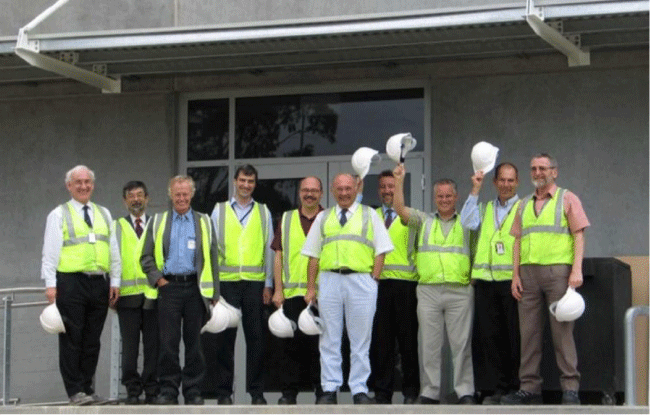
The display in honour of Tony Klein in Building 87 at ANSTO showing (in the centre) Geoff Opat and Tony Klein in an office at the University of Melbourne (with acknowledgement to Norman Wodetzki for permission to reproduce the photograph; reference number 200. 0003.00100 in the University of Melbourne Archives) and (at left) the template for the production of a circular neutron zone plate (Image courtesy of ANSTO).
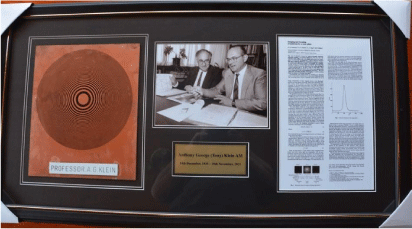
Creative teams
Arguably, Tony Klein and Geoff Opat made one of the most creative and best-known duos in Australian physics in the period 1980–2000. In his biographical memoir of Geoff Opat, Tony described his creative collaboration with Geoff as:
Two people who came from opposite ends of the academic spectrum: I am an electrical engineer who had gone in the direction of abstract physics and Geoff a theoretical physicist who had gone a long way towards pure experimentation. We met somewhere in the middle and struck sparks off each other.58
Many factors underpin individual and team creativity: intellect, personality and breadth of interest and experience, deep knowledge in a core discipline; a relationship built on trust, openness, and cooperation.59 Both had Jewish backgrounds with a respect for books and learning. Though not strictly observant Jews, they closely identified with their faith and its traditions. Both were ‘culture travellers’ with immigrant backgrounds. Geoff’s father, Sam, came to Australia in 1929 penniless from Poland and Tony’s family came from Romania via Israel in 1953. Both could speak several languages and brought multiple perspectives into their discussions.
Tony and Geoff were by nature curious and they were generous with time and ideas. Both had the playful, quirky sense of humour found in highly creative people. Both were music lovers who saw the beauty and harmony of good physics. Nick Sharman informed us that Tony invited him to perform a piece from Gilbert and Sullivan at the academy’s annual Victorian branch dinner in 1994 when Tony and Geoff were elected to academy fellowship. Tony was making the whimsical point that ‘Gilbert and Sullivan’ had also been elected.
In 1995, the team of Geoff Opat, Tony Klein, and Al Cimmino invented the ‘Rubbery Ruler’, a flexible elastic sensor for measuring length.60 The ‘Rubbery Ruler’ had medical, physiological, and horticultural applications. The European Space Agency inserted the ‘ruler’ in space suits, measuring crew movement in zero gravity.
Tony enjoyed many international collaborations, particularly involving neutron optics. Many of these collaborations were acknowledged in a special symposium on Neutron Interferometry and Coherence, organised by Tony Klein as part of the International Conference on Neutron Scattering (ICNS), held in Sydney from 27 November to 2 December, 2005, in honour of the pioneering work of Professor Sam Werner (Fig. 5). The fifteen presented papers with authors from many of the international groups involved in this area at the time, were published in one section of the overall ICNS published proceedings.61 The collaborative groups had made major contributions to the development of the field of neutron optics. Tony’s contributions had begun with the initial Klein and Opat paper,62 and continued through to 2014,63 long after he retired.
Tony Klein (left) with Professor Sam Werrner during ICNS (2005) in Sydney (Image courtesy of Dr Rob Robinson).
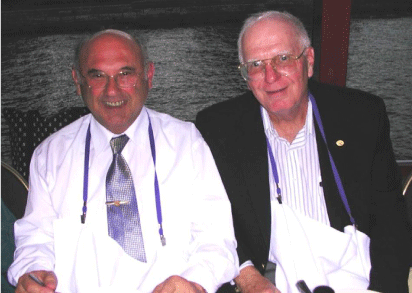
In his introduction to the symposium,64 Tony Klein acknowledged certain important international collaborators who had been unable to attend the Sydney conference. Notable amongst these was Anton Zeilinger of the University of Vienna, who in 2022 was to share the Nobel Prize for his experiments on quantum entanglement. It is worth noting that Tony had five collaborative publications with Zeilinger who had visited the School of Physics at the University of Melbourne in 1982 (Fig. 6). The most cited of these publications was entitled ‘Neutron Optical Tests of Non-Linear Wave Mechanics’,65 having 182 citations on Google Scholar at the time of writing. A full list of Klein’s publications is contained in the bibliography that forms part of the Supplementary Material that accompanies this memoir.
Melbourne University, Particle and Fields Group, 1982. (Back row, L→R): Steven Wark, Tony Klein, Mark Grigg, Frank Rossi, Helen Beggs, Geoff Opat, Anton Zeilinger, Bill Wignall, Colin Ramm. (Seated, L→R): Tim Davis, Tim Darling, Al Cimmino, Gareth Moorhead, Bill Hamilton, Terry Harders (Image courtesy of Tim Davis).
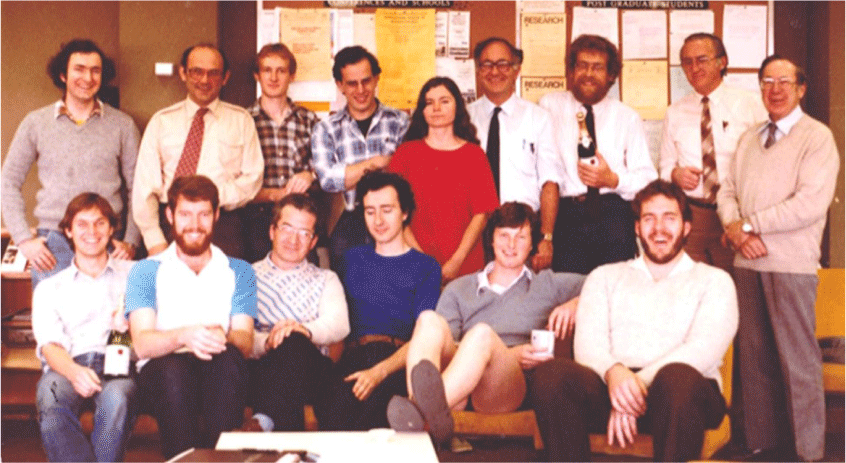
Teacher and communicator
Tony, an outstanding science communicator, could explain scientific theories and concepts simply and cogently. He wrote a regular science column for the Age newspaper in the 1980s. In July 1969, ABC TV invited him to give live commentary on the Apollo 11 moon mission landing. Tony, in the studio, interpreted the blurry images that Apollo 11 sent from space and the moon and explained to fascinated viewers what was happening. He became an instant, overnight TV celebrity recognised on the street, on public transport, and around the university. The physics workshop crafted a brass trophy inscribed ‘The Semi-Award-A.G. Klein Lunatic’ to celebrate Tony’s new fame. Tony was invited in the next two years to provide TV commentary on the Apollo 12 and 13 missions.
He was a gifted teacher. Carolyn Rasmussen wrote about Tony’s physics teaching: ‘He instinctively thought about how best to teach difficult and unfamiliar subjects … For Tony the interesting lecture became an intellectual adventure’.66
Collaborator and collector
Throughout Tony’s career, a key to his success was his talent as a generous, highly capable research collaborator, who partnered successfully with colleagues in neutron physics in Melbourne, Geneva, Brookhaven NY, Missouri, and Cambridge. He also collaborated successfully with researchers in other disciplines. He collaborated with Robyn Sloggett, an art conservator at the University of Melbourne and Tom O’Donnell, a professor of chemistry, on a 1991 ARC Project entitled Materials Analysis and Provenance Documentation for Authentication of Australian Paintings (1850–1921),67 applying novel techniques based on optical physics.
Tony had a keen eye for discarded objects to tinker with or to adorn buildings. On his daily walks, he searched for discarded objects to be turned into useful gadgets. He persuaded the Carlton and United Brewery to donate the iconic metal crown on its old building in Swanston Street and have it placed in the School of Physics courtyard (Fig. 7).
Honours and recognition
Tony Klein was recognised and honoured with many awards during his career.
His student record card from the University of Melbourne includes the award of the Dixson Scholarship for the final year of his BEE (1957).68
With Geoff Opat, he was jointly awarded the Australian Institute of Physics 1990 Walter Boas Medal: ‘For their work on fundamental studies of the physics of neutrons and their interactions as test of fundamental principles in Quantum Mechanics and Electrodynamics’.69
In accepting this award, Tony gave a presentation entitled ‘Do Neutrons Feel Electric Fields’ based on the collaboration between the Melbourne and Missouri groups and published in a co-authored paper.70 Tony was also an Honorary Fellow of the AIP.
Tony was appointed a Member of the Order of Australia (AM) in the Queen’s Birthday Honours of 1999, for which the citation read: For service to science, particularly as a researcher in the field of neutron optics, and the community through the Royal Victorian Eye and Ear Hospital.71
He was awarded a Centenary medal in 2001, for service to Australian society and science in experimental physics.
In 2016, he was awarded the W. H. (Beattie) Steel Medal of the Australian Optical Society.
In 2017, the University of Melbourne honoured Tony with a bronze plaque on Professors’ Walk near the entrance to University House, which reads: ‘Eminent researcher in physics, Inspirational lecturer, Highly regarded leader and mentor’, as you can see in Fig. 9 below.
Life outside physics, travels and adventures, interests, and pastimes
Tony’s entry in Who’s Who in Australia 2002 lists his recreations as reading, boating, and bushwalking. He loved being near water. In their leisure time, Tony and Suzanne, and friends Peter and Catherine McTigue and sometimes David and Karan Satchell, explored the Murray River in motor-powered, rubber dinghies carrying supplies and pup tents. In over forty trips, they travelled downstream on the Murray River into South Australia (Fig. 8). They also explored rivers in Gippsland, New South Wales, and Tasmania. Tim Davis recalls that Anton Zeiliger spoke of Tony Klein’s annual raft regatta down the Yarra River, as the ‘Yarrathon’, and that it was usually followed by a barbecue.
Suzanne and Tony Klein enjoying the outdoors along the Murray River (Image courtesy of Suzanne Klein).
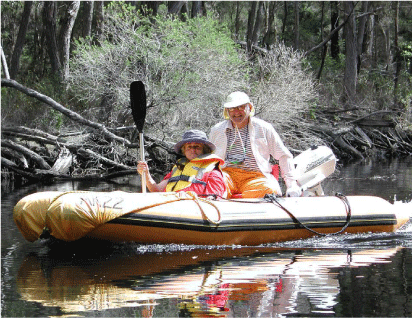
Tony was an intrepid traveller. He trekked in national parks in Malaysia in search of orangutans. His memoir records ocean voyages and scenic road journeys in many countries. Tony and Suzanne joined the expeditions to Lizard Island, Queensland, led by his friend Bruce Livett, a biochemist, annually for three years. The expeditions studied the composition and pharmacology of the venoms of species of genus Conus and discovered the cone shell’s paralytic toxins can be a source of powerful analgesics for the control of pain.72 Each day a team of snorkelers swam in search of the genus Conus. Tony, a valued team member, had a trained eye for spotting and collecting the Conus shells with tongs. He was fascinated by the structure and chirality of the Conus shells and how their pattern duplicated the Fibonacci sequence.
Friends and colleagues
From around the early 1990s, Tony was a core member of a diverse group of University of Melbourne senior academics from many faculties and disciplines, who dined together weekly in University House and engaged in robust discussion about university politics, academe, new research challenges, ideas, and discoveries. The group (Fig. 9) was a veritable learning circle and an incubator of news, good conversation, and fresh ideas and became known as ‘The Water Table’. Tony was a respected conversationalist and an intellectual leader of the group, apparently named by Tony because many in the group had interests in water hydrology and engineering, and possibly because the first to arrive at lunch would bring water to the table.
Some ‘Water Table’ friends together with Tony Klein’s daughter and son-in-law, around the bronze plaque (enlarged and inserted) on Professors’ Walk in front of University House. (L→R): Geoff Lacey, Rob Day, Nigel Swift (Anita’s husband), Trevor Finlayson, Peter Baines, Leon Mann, Greta Day, Anita Klein, Graeme Moore (December, 2022) (Image courtesy of the authors).
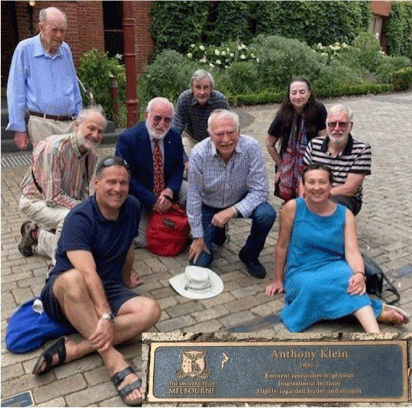
On a personal level Tony had an enormous store of anecdotes and jokes. He was a great raconteur and was the life and soul of any party.
End of life tributes
Following his passing, Tony Klein was honoured with several tributes worth recording here.
Prior to Tony Klein’s passing on 18 November 2021, the annual School of Physics Christmas lunch had already been booked for 14 December. Hence on this day, the school celebrated Tony Klein Day for which during the morning there was a scientific meeting at which colleagues gave presentations of their collaborations and interactions with Tony. This was followed by the traditional Christmas lunch and a ‘Wake’ in the afternoon at which stories were told of memorable experiences with Tony, his life, and his contributions to science and the university. A dinner followed in University House.
Tony has also been honoured with tribute articles in Australian Physics,73 Neutron News,74 the Age75 and Australian Jewish News.76
The display which is now in the ACNS Building 87 at ANSTO, (Fig. 7), has already been mentioned.
Finally, he was honoured with a special session during the 24th National Congress of the AIP held in Adelaide from 11 to 16 December 2022. The Tony Klein Memorial was programmed during a lunch time, enabling the attendance of as many congress delegates as possible. There were three invited presentations: Professor Lloyd Hollenberg chose the topic ‘Tony Klein and Geoff Opat: pioneers of neutron optics’; Emeritus Professor Bruce McKellar spoke on ‘The He-McKellar-Wilkins phase shift, atom interferometry tests—recent work related to Aharonov, Casher, Klein and others’; and Professor John Close summarised the current status of ‘Atom interferometry: current technology and future directions from basic science to applications’, a topic of ongoing research within his group at the Australian National University but which had its very beginnings with an experiment for the design of which Tony Klein and Geoff Opat had some input several years earlier.
Concluding comments
The last year of Tony’s life 2021 was difficult as he battled ill health in a year of Covid-19 anxiety, lockdowns, and restrictions. He missed seeing friends, visiting family overseas, boating and walking, coming to the university and lunching with the Water Table in University House. His passing on 18 November 2021, was mourned by his wife Suzanne, his best friend for fifty years, his two daughters, Anita and Stella from his first marriage to Mavis, his stepsons, Ian and Peter, Suzanne’s children, and his grandchildren and great grandchildren. He was also mourned by a wide circle of friends, colleagues, and former students who admired Tony for his intellect, curiosity, honesty, generosity of spirit, and good humour.
Tony was buried in Lyndhurst Jewish cemetery. Although a secular Jew, he deeply valued his heritage and religion. Tony wrote in his memoir: ‘My Hebrew name is Asher Nathan ben Yitzhak’,77 meaning Anthony (Asher), son (ben) of Emeric (Yitzhak).’ In his last years he embraced his Jewish identity. He sent friends greetings on Shabbat and on the Jewish holydays. He exchanged Jewish jokes and witticisms. He took a keen interest in Israeli politics and as a witness to the Holocaust, was deeply concerned by the world-wide resurgence of anti-Semitism.
In his lifetime, Tony made an outstanding contribution to scientific knowledge as a gifted teacher and communicator, champion and advocate for science, dedicated mentor, leader in scientific organisations, and a researcher who, in partnership with others in several countries, made pioneering research discoveries that helped shape experimental physics and the field of neutron interferometry.
Conflicts of interest
The authors declare no conflict of interest. Each of them is a friend and a colleague of Tony Klein.
Acknowledgements
The authors acknowledge the following sources of information about Anthony George Klein, which have been of great assistance in the preparation of this article: Tony Klein memoirs, kindly provided by Anita Klein, the Executor of his estate, but which are now legally digitised and catalogued in the University of Melbourne Archives.78 Australian Academy of Science Fellowship Summary Report, supplied by Archivist, Clare McLellan. Professors Ann Roberts and Stephen Collins, for information concerning the ANZOS. Dr Rob Robinson for information concerning Tony Klein’s service to the ANSTO Beam Instrument Advisory Group. Associate Professor Robert Day and Dr Graham Moore for their critical reading of and comments on the manuscript.
References
Aharonov, Y., and Susskind, L. (1967) Observability of the sign change of spinors under 2π rotations, Physical Review, 158(5), 1237-1238.
| Crossref | Google Scholar |
Bernstein, H. J. (1967) Spin precession during interferometry of fermions and the phase factor associated with rotations through 2π radians, Physical Review Letters, 18(24), 1102-1103.
| Crossref | Google Scholar |
Broxton, N. M., Down, J. G., Gehrmann, J., Alewood, P. F., Satchell, D. G., and Livett, B. G. (1999) α-Conotoxin ImI inhibits the α-bungarotoxin resistant nicotinic response in bovine adrenal chromaffin cells, Journal of Neurochemistry, 72(4), 1656-1662.
| Crossref | Google Scholar | PubMed |
Burrows, R. D., Caro, D. E., Gold, E., Klein, A. G., MacDowell, C. E., Oldey, J. L., Opat, G. I., Starr, J., Wignall, J. W. G., and Peaslee, D. C. (1970) pd topological cross sections in momentum range 50–920 MeV/c, Australian Journal of Physics, 23(5), 819-822.
| Crossref | Google Scholar |
Caro, D. E., Gold, E., Klein, A. G., MacDowell, C. E., Opat, G. I., and Wignall, J. W. G. (1973a) Elastic antiproton-deutron scattering below 1.0 GeV/c, Nuclear Physics B, 52(1), 239-247.
| Crossref | Google Scholar |
Caro, D. E., Gold, E., Klein, A. G., MacDowell, C. E., Opat, G. I., and Wignall, J. W. G. (1973b) Antiproton-nucleon scattering in deuterium below 1.0 GeV/c, Nuclear Physics B, 52(1), 301-315.
| Crossref | Google Scholar |
Caro, D. E., Gold, E., Klein, A. G., Opat, G. I., and Wignall, J. W. G. (1975) Antiproton-neutron annihilation in flight: a test of the Orfanidis-Rittenberg statistical model, Nuclear Physics B, 90(2), 221-226.
| Crossref | Google Scholar |
Cimmino, A., Opat, G. I., Klein, A. G., Kaiser, H., Werner, S. A., Arif, M., and Clothier, R. (1989) Observation of the topological Aharonov-Casher phase shift by neutron interferometry, Physical Review Letters, 63(4), 380-383.
| Crossref | Google Scholar | PubMed |
Fox, G. W., and Carr, P. H. (1931) The effect of piezoelectric oscillation on the intensity of X-ray reflections from quartz, Physical Review, 37(12), 1622-1625.
| Crossref | Google Scholar |
Gähler, R., Klein, A. G., and Zeilinger, A. (1981) Neutron optical tests of non-linear wave mechanics, Physical Review A, 23(4), 1611-1617.
| Crossref | Google Scholar |
Gillot, J., Lepoutre, S., Gauguet, A., Vigué, J., and Büchner, M. (2014) Measurement of the Aharonov-Casher geometric phase with a separated-arm atom interferometer, The European Physical Journal D, 68(6), 168.
| Crossref | Google Scholar |
Gold, E., Mason, G. C., Opat, G. I., Parker, K. R., Wignall, J. W. G., Chapman, G. J., De Roach, J. N., King, P. A., Klein, A. G., Martin, L. J., and Tovey, S. N. (1977) Beam target reversal symmetry in anti-proton-neutron interactions in flight, Physical Review D, 16(9), 2679-2686.
| Crossref | Google Scholar |
Kasper, P., Chapman, G., De Roach, J., Gold, E., Klein, A. G., Martin, L. J., Mason, G. C., Opat, G. I., Parker, K., Tovey, S. N., and Wignall, J. W. G. (1979) Resonance production in the reaction pd→psπ+π−π−π0 at 0.4 to 0.9 GeV/c antiproton momenta, Nuclear Physics B, 156(2), 207-224.
| Crossref | Google Scholar |
Kearney, P. D., Klein, A. G., Opat, G. I., and Gähler, R. (1980) Imaging and focusing of neutrons by a zone plate, Nature, 287(5780), 313-314.
| Crossref | Google Scholar |
Klein, A. G. (1961) Logarithmic rate meters and period meters—a theoretical study of noise and transient response, Nuclear Science and Engineering, 11(2), 142-153.
| Crossref | Google Scholar |
Klein, A. G. (1990) President’s column 'Woorlookadat’, The Australian Physicist, 27(1/2), 2-3.
| Google Scholar |
Klein, A. G. (1991) The old president’s last column, Australian and New Zealand Physicist, 28(4), 50.
| Google Scholar |
Klein, A. G. (2005) Geoffrey Ivan Opat 1935–2002, Historical Records of Australian Science, 16(1), 65-89.
| Crossref | Google Scholar |
Klein, A. G. (2006) Introduction to the neutron interferometry and coherence symposium, Physica B: Condensed Matter, 385–386, 1355.
| Crossref | Google Scholar |
Klein, A. G., and Opat, G. I. (1975) Observability of 2π rotations: a proposed experiment, Physical Review D, 11(3), 523-528.
| Crossref | Google Scholar |
Klein, A. G., and Opat, G. I. (1976) Observation of 2π rotations by Fresnel diffraction of neutrons, Physical Review Letters, 37(5), 238-240.
| Crossref | Google Scholar |
Klein, A. G., and Werner, S. A. (1983) Neutron optics, Reports on Progress in Physics, 46(3), 259-335.
| Crossref | Google Scholar |
Klein, T., and Werner, S. (1991) Do neutrons feel electric fields? Neutron News, 2(3), 19-22.
| Crossref | Google Scholar |
Klein, A. G., Prager, P., Wagenfeld, H., Ellis, P. J., and Sabine, T. M. (1967) Diffraction of neutrons and x-rays by a vibrating quartz crystal, Applied Physics Letters, 10(10), 293-295.
| Crossref | Google Scholar |
Klein, A. G., Opat, G. I., Cimmino, A., Zeilinger, A., Treimer, W., and Gähler, R. (1981a) Neutron propagation in moving matter: the Fizeau experiment with massive particles, Physical Review Letters, 46(24), 1551-1554.
| Crossref | Google Scholar |
Klein, A. G., Kearney, P. D., Opat, G. I., and Gähler, R. (1981b) Focussing of slow neutrons with cylindrical zone plates, Physics Letters, 83A(2), 71-73.
| Google Scholar |
Kulin, G. V., Frank, A. I., Bushuev, V. A., Khaydukov, Y. N., Roshchupkin, D. V., Vadilonga, S., and Sergeev, A. P. (2020) Nonstationary neutron diffraction by surface acoustic waves, Physical Review B, 101(16), 165419.
| Crossref | Google Scholar |
McKellar, B. H. J., and Volkas, R. (2022) Vale Tony Klein, Australian Physics, 59(1), 29-30.
| Google Scholar |
McKellar, B. H. J., He, X. G., and Klein, A. G. (2014) Topological phases reviewed: the Aharonov Bohm, Aharonov Casher and He McKellar Wilkens phases, Frontiers in Physics, 1588(1), 59-70.
| Crossref | Google Scholar |
Melzer, L., and Sloggett, R. (2022) Compounding value: delivering to core university needs through conservation teaching, research, and outward facing engagement, University Museums and Collections Journal, 14(1), 8-14.
| Google Scholar |
Parkinson, T. F., and Moyer, M. W. (1966) Modulation of diffracted neutrons with a piezoelectric crystal, Nature, 211, 400-401.
| Crossref | Google Scholar |
Pryor, A. W., and Klein, A. G. (1959) Statistical design basis for fast scaling systems, Nuclear Instruments and Methods, 4(1), 1-4.
| Crossref | Google Scholar |
Rangaswamy, T. N., Gurtu, A., Malhotra, P. K., Raghavan, R., Subramanian, A., Sudhakar, K., Chapman, G. J., Klein, A. G., Mason, G. C., Opat, G. I., Tovey, S. N., and Wignall, J. W. G. (1979) Search for direct electron production in p̅p interactions at 2.0 GeV/c, Nuclear Physics B, 151(1), 71-80.
| Crossref | Google Scholar |
Rauch, H., Zeilinger, A., Badurek, G., Wilfing, A., Bauspiess, W., and Bonse, U. (1975) Verification of coherent spinor rotation of fermions, Physics Letters A, 54(6), 425-427.
| Crossref | Google Scholar |
Robinson, R., and Finlayson, T. (2022) Anthony (Tony) George Klein (1935–2021), Neutron News, 33(2), 19.
| Crossref | Google Scholar |
Sangster, K., Hinds, E. A., Barnett, S. M., Riis, E., and Sinclair, A. G. (1995) Aharonov-Casher phase in an atomic system, Physical Review A, 51(3), 1776-1786.
| Crossref | Google Scholar | PubMed |
Tovey, S. N., Parker, K. R., Chapman, G. J., De Roach, J., Gold, E., Kasper, P., King, P. A., Klein, A. G., Martin, L. J., Mason, G. C., Opat, G. I., and Wignall, J. W. G. (1978) Reaction p̅n → π−π−π+ at incident momenta below 1 GeV/c, Physical Review D, 17(9), 2206-2215.
| Crossref | Google Scholar |
Werner, S. A., Colella, R., Overhauser, A. W., and Eagen, C. F. (1975) Observation of the phase shift of a neutron due to precession in a magnetic field, Physical Review Letters, 35(16), 1053-1055.
| Crossref | Google Scholar |
Footnotes
1 Klein (2007).
2 Klein (2007) p. 27.
3 Klein (1990).
4 Klein (2007) p. 23.
5 Klein (2007) pp. 41–42.
6 Klein (2007) pp. 42–43.
7 Klein (2005).
8 Klein (2007) p. 44.
12 Packer (1997).
13 Klein (2007) pp. 55–56.
15 Klein (1961).
16 Klein (2007) p. 84.
17 en.wikipedia.org/wiki.Borrmann_effect, accessed 12 July, 2023.
22 Miller (1987).
23 Klein (2005).
24 https://www.smh.com.au/national/explorer-of-the-micro-universe-20031027-gdhnwy.html, viewed 5 June 2023.
25 en.wikipedia.org/wiki/Otto_Robert_Frisch, viewed 5 June 2023.
26 Burrows and others (1970), Caro and others (1973a, 1973b, 1975), Gold and others (1977), Tovey and others (1978), Rangaswamy and others (1979), Kasper and others (1979).
29 Bernstein (1967).
33 Klein (1976).
34 Cimmino (1981).
35 en.wikipedia.org/wiki/Fizeau experiment, accessed 8 June 2023.
38 Hamilton (1987).
39 Allman (1994).
40 Klein (1986).
49 Science.org.au/profile/tony-klein, accessed 12 October 2023.
52 Klein (1991).
53 https://optics.org.au/WH-Beattie-Steel-Medal, accessed 14 July 2023.
55 Hugh R. Taylor, former Professor of Ophthalmology, Royal Victorian Eye and Ear Hospital (email correspondence; 26 September 2023).
57 Kearney (1988).
58 Klein (2005).
59 Mann (2005).
60 https://www.ph.unimelb.edu.au/inventions/rubberyruler/brochure.html, viewed 6 September 2023.
61 Proceedings of the Eighth International Conference on Neutron Scattering (ICNS 2005), Physica B 385–386 Part II, pp. 1355–1413 (2006).
64 Klein (2006).
66 Rasmussen (2018).
68 Student card for Anthony George Klein, University of Melbourne Archives for (Klein, Anthony George), 1957.
71 en.wikipedia.org/wiki/1999_Queen%27s_Birthday_Honours_(Australia), viewed 3 August 2023.
77 Klein (2007) p. 1.
78 Klein (2007).


